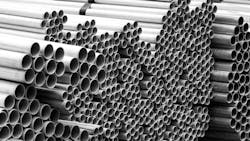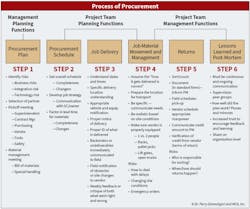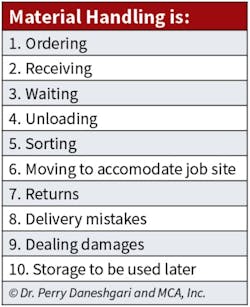Streamlining Construction Procurement: Strategies for Effective Material Management
Key Takeaways
- Effective procurement involves detailed planning, scheduling, and coordination across management, project teams, and vendors to meet project deadlines.
- Material handling encompasses ordering, receiving, unloading, sorting, storing, and managing returns, all of which impact labor productivity and project costs.
- Maintaining around three days' worth of materials on site balances flexibility with inventory control, reducing disruptions and excess stock.
- Prefabrication and procurement support can improve safety, reliability, and predictability while enabling parallel work streams and reducing project duration.
- Implementing a digital system for interconnecting project information helps reduce risks, optimize labor, and ensure materials are available exactly when needed.
- Having a procurement plan
- Building a procurement schedule
- Job delivery
- Job material movement
- and management
- Returns
- Lessons learned and post-mortem
Material handling: What is it, and who is doing it?
Material handling is much more than simply ordering and receiving. Material handling, by definition, based on a study done by MCA, Inc. for Electri International, formerly Electri21, can be as much as 40% of an electrician’s time. Recognizing all the items involved in material handling that impact your labor productivity and your project’s profitability is shown in Table. This includes:
- Ordering (whether it’s a call to your inside sales, done by the project team, or the prefab shop, done online, with a material request form). Are you doing it daily or weekly?
- Receiving (at the job site, at the warehouse, in the office, etc.). Planning this is a large portion of Step 3 of the PoP.
- Waiting (for someone to answer your call or the delivery truck to come).
- Unloading (think of how many people it takes to unload the truck and what happens if you have to pull your crew off to do this).
- Sorting (through the delivery that likely has many items mixed in boxes or individual boxes needing to be opened to confirm everything is there).
- Moving to accommodate job site (you have your location on the job site where you’re storing things, but you have to move to the installation location, or move your laydown area when the job progresses).
- Returns (MCA, Inc.’s research shows that the main reason for returns is overordering, which can be caused by finding/moving material on the job site).
- Delivery mistakes (no one’s perfect).
- Dealing with damages (items ordered early that get shuffled or actual issues with damage from the manufacturer, vendor, or distributor).
- Storing material that will be used later (linked to moving to accommodate the job site, early ordering can cause issues like noted above, such frequent movement or issues with the elements).
Recognizing what’s involved in material management will allow your team to work on tasks where they can excel. Per Step 1 in the PoP, it’s also important to consider asking your vendor partners to support you. The key isn’t in the labor rate; it’s in the productive installation hours of the highly skilled employee. Both employees will work all day and will work hard; however, you’ll gain minimal revenue and billing from a lesser-skilled person moving material in contrast to what you can achieve by having the highly skilled electrician complete installation tasks.
Highly trained and highly experienced electricians don’t want to spend their days moving material; they want to be doing electrical work. Build on/accelerate the support of your highly skilled labor doing what they’re best at, love to do, and are trained for! Keeping your teams working on installation is key.
Should we buy more often?
The simple answer is no! To reduce material management/handling on job sites, focus on ordering materials that you need now. While electrical distributors are happy to take your order and are likely to even deliver it to you daily, this isn’t the most efficient process for specialty trade contractors. MCA’s research shows that about three days’ worth of material on the job site is the “right” amount. Frequent deliveries can slow you down. They create constant disruptions from unloading, sorting, checking, and staging.
Why? Because, as you know, job sites and job progress are constantly changing in the construction industry. No matter how hard we try, we can’t always do everything that we plan each day, not for the whole job and not even for a week or two in advance. In fact, MCA’s research has shown that having less than three days’ material available for installation leaves you with no ability to adjust to changes in today’s conditions.
If you have too little material, then simple redirection starves the labor and reduces productivity. Having material on site too early equates to having too much inventory on the job site. Too much inventory needs to be moved, counted, monitored, and often repaired or replaced. The answer is three days, because three days is about as far ahead as the job conditions are predictable.
Years ago, “just-in-time inventory” was a big craze. The principles and concepts are still with us today, and continue to expand to provide more cost-effective and productivity-supporting material management and logistics practices. The concept is simple; it’s based on the Toyota Production System, translated to construction, that to work, you need to have the materials required, when and where the installation is to occur, but not more than that — not more and not less. Not way before and not after you need it. MCA Inc’s previous EC&M article (November 2024) "Best Practices for Getting Material as Needed" is a great reference with a material ordering checklist and some thoughts around getting material from your vendors.
Can prefabrication impact material management?
You could use kitted prefab solutions, so everything shows up exactly when and how you need it, ready to install with no extra steps. Additionally, you could work with a partner to provide procurement assistance to enhance productivity, ensuring that materials are ordered and delivered in the most efficient manner possible.
It’s important to be more expansive and think beyond prefabrication. This could lead to benefits such as:
- Increased safety, reliability, and predictability
- Controlled environment
- Buffer for labor allocation (can do things in parallel vs. in series on the job site)
- Can reduce project duration.
- Get more work in the long run.
Using the eight steps in the PoP in the Figure and interconnecting information within your company with an easy system allows you to reduce risk and keep your employees focused on labor productivity. As discussed at the start, it requires planning the work, managing the labor, procuring materials, managing subcontractors, and confirming you have the right equipment and tools while negotiating between other trades and typically working with the general contractor or construction manager to negotiate the schedule and hit the dates required. To reduce time and cost spent on material management/handling, it’s important to:
- Segregate the on-site electrical work based on experience.
- Optimize orders and deliveries to every three days.
- Use a checklist to get your material as you need it by working with your vendor partners.
- Externalize work as much as possible.
It’s really about making a plan and working with your team and the supply chain to have the right people doing what they do best.
About the Author
Jennifer Daneshgari
Jennifer Daneshgari is the vice president of financial services at MCA, Inc. She can be reached at [email protected].
Dr. Heather Moore
Vice President of Operations
Dr. Heather Moore is VP for customer care and support at MCA, Inc., as well as a well-known researcher and author in the construction industry. Dr. Heather can be reached at [email protected]. She is also part-owner of a WBENC-certified company, WEM, LLC, that provides logistics and scheduling services for the construction industry, as well as being the only licensed reseller of MCA, Inc.’s software products that are focused on Making Productivity Visible to Everyone®.


